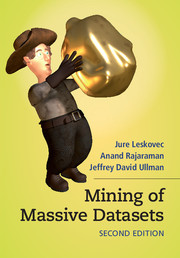Book contents
- Frontmatter
- Contents
- Preface
- 1 Data Mining
- 2 MapReduce and the New Software Stack
- 3 Finding Similar Items
- 4 Mining Data Streams
- 5 Link Analysis
- 6 Frequent Itemsets
- 7 Clustering
- 8 Advertising on the Web
- 9 Recommendation Systems
- 10 Mining Social-Network Graphs
- 11 Dimensionality Reduction
- 12 Large-Scale Machine Learning
- Index
- References
12 - Large-Scale Machine Learning
Published online by Cambridge University Press: 05 December 2014
- Frontmatter
- Contents
- Preface
- 1 Data Mining
- 2 MapReduce and the New Software Stack
- 3 Finding Similar Items
- 4 Mining Data Streams
- 5 Link Analysis
- 6 Frequent Itemsets
- 7 Clustering
- 8 Advertising on the Web
- 9 Recommendation Systems
- 10 Mining Social-Network Graphs
- 11 Dimensionality Reduction
- 12 Large-Scale Machine Learning
- Index
- References
Summary
Many algorithms are today classified as “machine learning.” These algorithms share, with the other algorithms studied in this book, the goal of extracting information from data. All algorithms for analysis of data are designed to produce a useful summary of the data, from which decisions are made. Among many examples, the frequent-itemset analysis that we did in Chapter 6 produces information like association rules, which can then be used for planning a sales strategy or for many other purposes.
However, algorithms called “machine learning” not only summarize our data; they are perceived as learning a model or classifier from the data, and thus discover something about data that will be seen in the future. For instance, the clustering algorithms discussed in Chapter 7 produce clusters that not only tell us something about the data being analyzed (the training set), but they allow us to classify future data into one of the clusters that result from the clustering algorithm. Thus, machine-learning enthusiasts often speak of clustering with the neologism “unsupervised learning”; the term unsupervised refers to the fact that the input data does not tell the clustering algorithm what the clusters should be. In supervised machine learning, which is the subject of this chapter, the available data includes information about the correct way to classify at least some of the data. The data already classified is called the training set.
In this chapter, we do not attempt to cover all the different approaches to machine learning. We concentrate on methods that are suitable for very large data and that have the potential for parallel implementation. We consider the classical “perceptron” approach to learning a data classifier, where a hyperplane that separates two classes is sought. Then, we look at more modern techniques involving support-vector machines. Similar to perceptrons, these methods look for hyperplanes that best divide the classes, so that few, if any, members of the training set lie close to the hyperplane. We end with a discussion of nearest-neighbor techniques, where data is classified according to the class(es) of their nearest neighbors in some space.
Information
- Type
- Chapter
- Information
- Mining of Massive Datasets , pp. 415 - 458Publisher: Cambridge University PressPrint publication year: 2014
